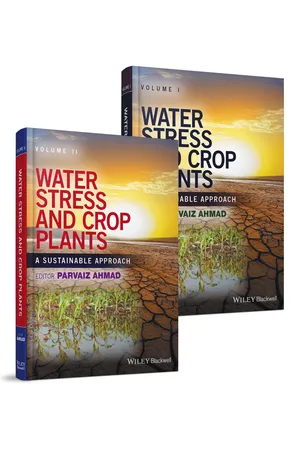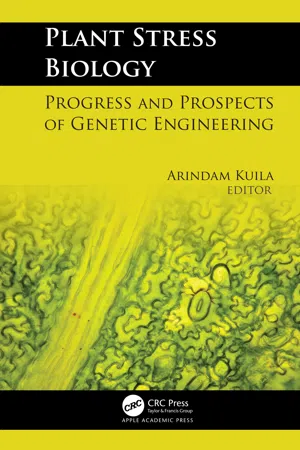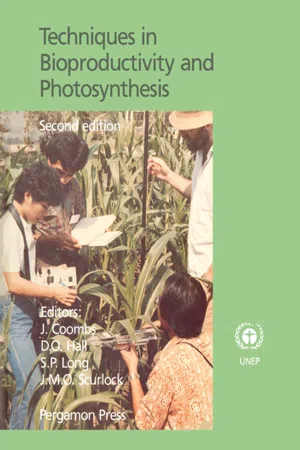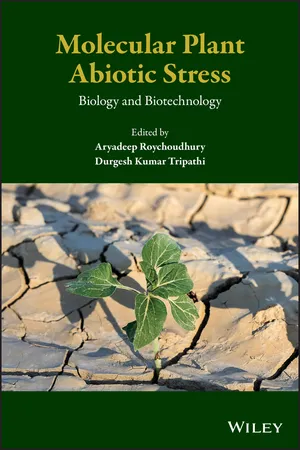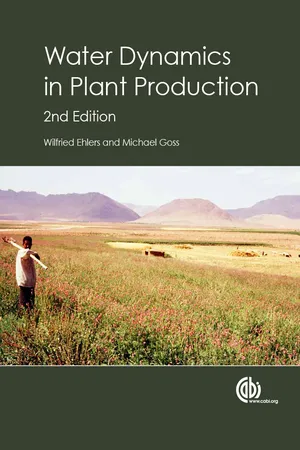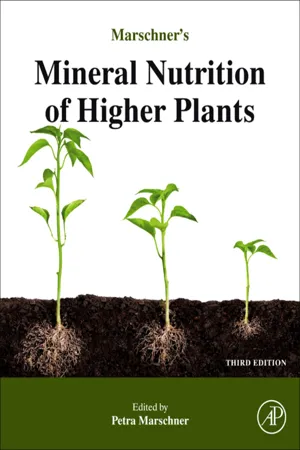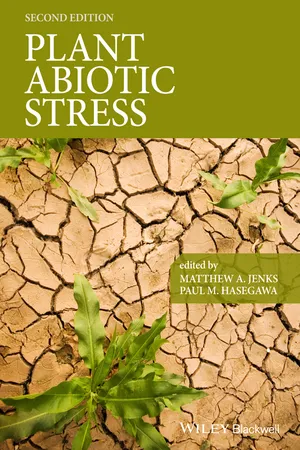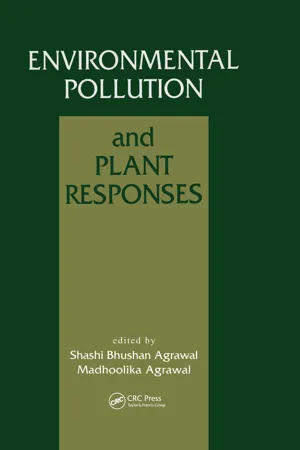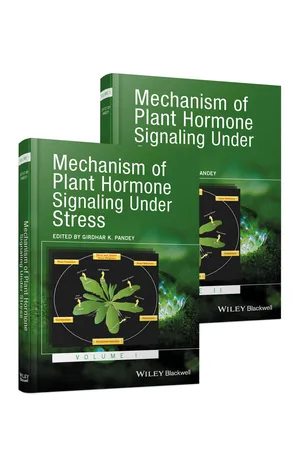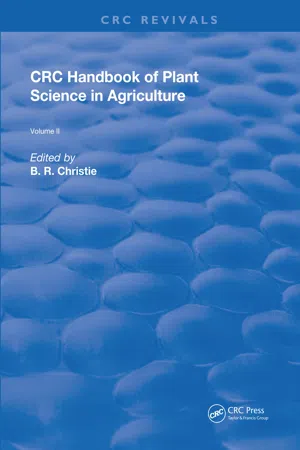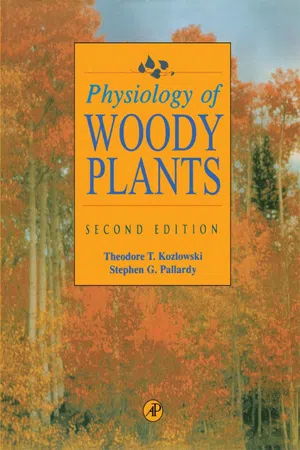Biological Sciences
Stomata
Stomata are small pores found on the surface of plant leaves and stems that regulate gas exchange and water loss. They open to allow carbon dioxide to enter for photosynthesis and close to minimize water loss through transpiration. Stomata play a crucial role in maintaining the balance between carbon dioxide uptake and water conservation in plants.
Written by Perlego with AI-assistance
Related key terms
Related key terms
1 of 4
Related key terms
1 of 3
12 Key excerpts on "Stomata"
- eBook - ePub
Water Stress and Crop Plants
A Sustainable Approach
- Parvaiz Ahmad, Parvaiz Ahmad(Authors)
- 2016(Publication Date)
- Wiley-Blackwell(Publisher)
CHAPTER 3 Stomatal responses to drought stressHadi Pirasteh-Anosheh1 , Armin Saed-Moucheshi2 , Hassan Pakniyat2 , and Mohammad Pessarakli31 National Salinity Research Center, Yazd, Iran 2 Crop Production and Plant Breeding Department, College of Agriculture, Shiraz University, Shiraz, Iran 3 School of Plant Sciences, The University of Arizona, Tuscan, Arizona, USA3.1 Introduction
Stomata are pores found in the epidermis of leaf and stem and participate in exchange of water and gaseous. Stomata (plural of stoma) are usually most abundant on the lower surface of the leaf (Figure 3.1 ). The word stoma is derived from the Greek στόμα, “mouth”.Location of Stomata in plant leaf (Taiz and Zeiger, 2002), Stomata are usually most abundant on the lower surface of the leaf.Figure 3.1Stomata occur mostly on the lower surface of the leaf and new Stomata are generated continually during leaf growth (Zhao et al., 2015). They are of an anomocytic type, lacking distinct subsidiary cells. The epidermal cells are polygonal with waxy anticlinal walls (Karthikeyan et al., 2012). The pores are bordered by a pair of specialized cells known as “guard cells”. The guard cells are responsible for governing the opening size. The word “Stomata” is also used to refer to an entire Stomatal complex, both the pore itself and the guard cells (Figure 3.1 ). Air containing oxygen and carbon dioxide enters the plant through Stomata and is used in respiration and photosynthesis. Water vapor is released into the atmosphere through these pores in a process called transpiration (Esau, 2006).Guard cells, in grasses (Figure 3.2 ), are characterized by a dumbbell shape with bulbous ends. The pores are long slits that are located between the two “handles” of the dumbbells. The guard cells are always flanked by a pair of distinct epidermal cells called “subsidiary cells”. The subsidiary cells help the guard cells to control the Stomatal closure (Figure 3.3 ). The Stomatal complex collectively includes guard cells, subsidiary cells, and pores (Taiz and Zeiger, 2002; Berry et al - eBook - ePub
Plant Stress Biology
Progress and Prospects of Genetic Engineering
- Arindam Kuila, Arindam Kuila(Authors)
- 2020(Publication Date)
- Apple Academic Press(Publisher)
2 for the photosynthesis, and side effect of keeping their Stomata open during the day is that they lose 97% of the water they uptake to transpiration via Stomata Plant hormone abscisic acid (ABA) has been considered as very crucial in drought-induced Stomatal closing. The underlying mechanism of ABA triggered Stomata closing is quite well understood. In succinct, during drought, plants induce accumulation and signaling of ABA in guard cells through various ways. Increased ABA signaling leads to increase of cytosolic Ca+2 levels, which consequently activates various ion channels at plasma membrane and tonoplast, which leads to efflux of K+ and various anions from the cell, leading to loss of turgor in guard cells and closing of the Stomata. Although C3 plants have mechanisms to close their Stomata during day-time when they are faced with water-deficit conditions, (but in prolonged drought conditions, continuous closing of Stomata reduces plant’s capacity to: 1) regulate its temperature, (2) nutrient absorption by roots, and (3) photosynthesis, which leads to their death. Plants with crassulacean acid metabolism (CAM) have a mechanism for night-time carbon fixation, so they keep their Stomata closed during day-time to avoid this high rate of day time transpiration.8.1 INTRODUCTION
“Stoma” is originally derived from the ancient word “στόμα,” which means “inlet.” Small pores are found in the Stomata in the epidermis of leaf and stem, through which water vapor and gases are also passed. Stomata mainly present on the lower part of the leaf and new Stomata are generated continually during leaf development (Zhao et al., 2015). The Stomata term refers to the paired guard cells and the pore itself. Stomata are present in all land plants groups except liverworts; however, their number, size, and distribution vary considerably. The epidermal cells are polygonal in shape and their walls are waxy anticlinal (Karthikeyan et al., 2012). Pores are bordered by a couple of specific cells called guard cells, and specialized additional cells surround the two guard cells. Stomata are differentiated on the basis of their size, shape, and arrangement of the additional cells. Sometime Stomata are present as Stomatal crypts, which are at a lower surface of the leaf epidermis which forms a chamber-like shape that contains more than one Stomata. They are an irregular celled type, missing distinct additional cells. The guard cells are responsible for governing the opening size. Dicots and non-grass monocots have kidney liked shaped Stomata. Stomata permit the absorption of carbon dioxide necessary for photosynthesis from the air. The way to this mechanism is to suppose to be that the air inside the leaf is soaked with water vapor, with the immersion vapor pressure at that point computed by an exponential association with leaf temperature. - eBook - ePub
Techniques in Bioproductivity and Photosynthesis
Pergamon International Library of Science, Technology, Engineering and Social Studies
- J. Coombs, D. O. Hall, S. P. Long(Authors)
- 2014(Publication Date)
- Pergamon(Publisher)
Too much water loss would result in dehydration. Plants have therefore evolved leaves with an epidermis composed of a relatively impermeable cuticle and turgor-operated valves – Stomata. The epidermis not only reduces rates of CO 2 and water-vapour exchange, but it also provides a means of controlling assimilation and transpiration through the size of the Stomatal pores. Thus Stomata play a pivotal role in controlling the balance between water loss and carbon gain i.e. biomass production. Measurements of the size of the Stomatal opening (Stomatal aperture) or of the resistance to CO 2 and water vapour (H 2 O) transfer between the atmosphere and the internal tissue of the leaf imposed by the Stomata (Stomatal resistance) are important in many studies of biomass production. This is particularly the case in cropping situations where it is important to maximize water-use efficiency which we define as the mass of CO 2 assimilated (or dry weight gained) per unit mass of water transpired. 5.1.2 Resistance or conductance? The Ohm’s Law analogy of CO 2 and H 2 O diffusion has been described in Chapter 3. The restriction to the movement of CO 2 and H 2 O offered by the Stomata is defined there as a resistance (conceptually similar to an electrical resistance). The size of the Stomatal resistance is often compared with that of the boundary layer and the intracellular processes for CO 2 transfer. Comparison of resistances is both theoretically correct and biologically meaningful 6. However, if the limitation offered by Stomata is being compared with the flux of CO 2 and H 2 O, or being correlated with some biological or environmental variable such as leaf water status or deficit, it is more meaningful and less prone to misinterpretation to express it as a conductance (= 1/resistance) rather than as resistance 6, 11, 8. Fluxes are proportional to conductances (g) but inversely proportional to resistances (r). However, most instruments are calibrated against physical resistances - eBook - ePub
Molecular Plant Abiotic Stress
Biology and Biotechnology
- Aryadeep Roychoudhury, Durgesh K. Tripathi, Aryadeep Roychoudhury, Durgesh Kumar Tripathi(Authors)
- 2019(Publication Date)
- Wiley(Publisher)
1976 ). As described, there are different types of Stomata, but there is a common basis for Stomatal conductance in all of the types, which will be explained below.3.3 Stomatal Movement Mechanism
Stomatal conductance is the main mechanism controlling the transport of water vapor, gas exchanges, and the temperature of leaves (Jones 1998 ; Chaves et al. 2003 ; Salleo et al. 2000 ). The guard cells around the Stomatal pore regulate the Stomatal movement by controlling their pressure potential (Comstock 2002 ; Scarth 1927 ; Liu et al. 2003 ). As a consequence of water uptake or loss, owing to variation in the cation contents (especially K+ ) and anions, changes in pressure potential occur in guard cells. Cation and anion transport occur by the ion channels present in the plasma membrane and tonoplast of the guard cells (Blackman and Davies 1985 ; Chaves et al. 2002 ; Daszkowska‐Golec and Szarejko 2013 ; Kim et al. 2010 ). Plasmodesmata do not occur in mature guard cells, so most solute influx and efflux occur through transporters, ion channels and pumps localized in the plasmalemma and tonoplast. The H+ ‐ATPase pump belongs to the P‐type ATPases and is responsible for H+ efflux from the guard cells during Stomatal opening. In Arabidopsis, 11 genes for H+ ‐ATPase pump are characterized, which are expressed in the guard cells of plants (Ueno et al. 2005 ; Daszkowska‐Golec and Szarejko 2013 ). Auxin and blue light act as positive regulators of H+ ‐ATPase activity, whereas abscisic acid (ABA ) and Ca2+ function as negative regulators in guard cells. The efflux of H+ results in hyperpolarization of the plasma membrane and acidifies the apoplast, which increases K+ uptake through K+ channels, such as KAT1, KAT2, and AKT1 (Zhu 2002 ; Saibo et al. 2008 ; Daszkowska‐Golec and Szarejko 2013 ; Szyroki et al. 2001 ). K+ uptake is accompanied by counter‐ion influx, particularly Cl− and malate2− derived from the breakdown of starch, or NO−3 (Guo et al. 2003 ; Daszkowska‐Golec and Szarejko 2013 ). Ion transport into the guard cells accompanied by transport of water through aquaporins results in turgor that is proposed to open Stomata (Daszkowska‐Golec and Szarejko 2013 ; Kim et al. 2010 - eBook - ePub
- Wilfried Ehlers, Michael Goss(Authors)
- 2016(Publication Date)
- CAB International(Publisher)
7.5). The largest of these spaces is called the subStomatal cavity. From here the water vapour is lost from the leaves, using the diffusion path from the intercellular system through the Stomatal pores. A much smaller part is released from the epidermal cells through the waxy cuticle. The cuticular transpiration of mesophytes comes to no more than 3–5% of the total water loss, which mainly comprises the Stomatal transpiration. The stomates represent the prime passageways for the escaping water vapour. At the same time the stomates are the entrance openings for CO 2. By closing their stomates, plants are in a position to cut down the water loss very effectively when supplies run short, though closure has a harmful consequence for photosynthesis as the CO 2 supply is also cut. Fig. 7.5. Transpiration of a foliage leaf with abaxial stomates. Arrows indicate the pathway of liquid water and of water vapour. The molecules in vapour diffuse from the subStomatal cavities through the stomates to the outside of the leaf (after Nultsch, 1991). Stomatal pores are formed by guard cells, which are present in the epidermis (Fig. 7.5). In many crop plants the openings are placed not only on one side (Fig. 7.5) but on both sides of the leaf (Table 7.2). The density of stomates varies between less than 20 apertures mm –2 to more than 300 (Table 7.2). In many trees, however, like apple (Malus pumila), cherry (Prunus avium), olive (Olea europaea) or common oak (Quercus robur), the upper or adaxial leaf side is completely free of stomates. All the openings are located on the lower or abaxial side (Fig. 7.5). The density changes between 250 (Prunus) and 550 stomates (Olea) mm –2 (Flindt, 2000). Interestingly, aquatic plants like the water lily (Nymphea spp.) have concentrated their openings on the adaxial side for obvious reasons - eBook - ePub
- Horst Marschner(Author)
- 2011(Publication Date)
- Academic Press(Publisher)
The cuticle is a non-living, hydrophobic skin with a low permeability for water, gases and solutes. To enable CO 2 uptake, leaves are furthermore equipped with Stomata as adjustable apertures in the leaf surface, which optimize the trade-off between CO 2 uptake and water loss of plants. The evolutionary development of the cuticle and Stomata as barriers against the uncontrolled exchange of matter was the prerequisite for the colonization of the land surface by higher plants, but these barriers do not fully impede the exchange of both gaseous and dissolved nutrients. Gases, such as ammonia (NH 3) and sulphur dioxide (SO 2), may be taken up or released through open Stomata. Dissolved nutrients may penetrate the leaf surface in both directions, resulting both in foliar uptake of solutes originating from atmospheric deposition or foliar fertilization and in leaching of nutrients from leaves. 4.2. Uptake and Release of Gases and Other Volatile Compounds through Stomata In terrestrial plants, the Stomata (Fig. 4.1) are the sites of exchange of gases (mainly CO 2, O 2) with the atmosphere. Their number per mm 2 of leaf surface varies between about 20 in succulents (CAM species), 100–200 in most annual species, and more than 800 in certain tree species (e.g., Acer montanum). The Stomata are usually more abundant (most annual species) or confined (many tree species, e.g. Fagus sylvatica) to the lower (abaxial) leaf surface. Nutrients in the form of gases, such as SO 2, NH 3 and NO 2, also enter the leaves predominantly through the Stomata and are rapidly metabolized in the leaves. In recent years, foliar uptake of these gases has attracted much interest as they are major components of air pollution and their uptake can be substantial. Moreover, depending on concentration and the plant species, they can either reduce or enhance plant growth. For many gases, plant surfaces can act both as a source or a sink. The compensation point, i.e - eBook - ePub
- Matthew A. Jenks, Paul M. Hasegawa, Matthew A. Jenks, Paul M. Hasegawa(Authors)
- 2013(Publication Date)
- Wiley-Blackwell(Publisher)
In fact, a leaf may exchange up to 100% of its internal water every hour. This continuous cycling of water through the plant is called transpiration, a process that can be divided into two main components: (1) Stomatal transpiration, which is a gas-phase water diffusion through open Stomata, and (2) cuticular transpiration, which is the diffusion of solid-phase water across the cuticle membrane itself. Under water-sufficient conditions, the majority of water loss occurs through open Stomata. Under environmental conditions that cause Stomata to close, such as during drought, water loss is mainly executed via solid-phase cuticular transpiration. Körner et al. (1994) demonstrated the effects of Stomatal closure on water loss. The minimum conductance (g min) was found to range from < 1% of the maximum conductance (g max) in succulents to 5.6% of g max in herbaceous shade plants. Here, g min and g max correspond to the water loss when the Stomata are presumably closed and fully open, respectively. Thus, in well-watered environments, ~95–99% of all water loss occurs through the pores of Stomata. By comparison, in conditions where plants close their Stomata, such as during times of water insufficiency, water loss rates are determined primarily by the permeability of the plant cuticle. The diffusional resistance of the transpiration pathway consists of two varying components. One is the resistance associated with diffusion through the Stomatal pore, the leaf Stomatal resistance (r s), and another is the resistance due to the layer of unstirred air next to the leaf surface through which water vapor must diffuse to reach the turbulent air of the atmosphere, the leaf boundary layer resistance - eBook - ePub
- Shashi Bhushan Agrawal, Shashi Bhushan Agrawal(Authors)
- 2023(Publication Date)
- Routledge(Publisher)
2 has varied considerably on a millennium time scale, and because the need to conserve water is of the highest priority. This issue is relevant to our understanding of the hierarchy of priorities in resource capture and utilization which has governed many aspects of plant evolution.3.3 CO2 -INDUCED CHANGES IN StomataL APERTURE
The ability of Stomata to respond to changes in CO2 concentration was discovered and described by Freudenberger6 and Heath.7Heath and his co-workers subsequently evaluated the control mechanisms in great detail, and many of their conclusions still provide the foundation of our present understanding. A review by Heath8is recommended for a comprehensive summary of the conclusions that were drawn from experiments in which attempts were made to control the internal atmosphere of the leaf (i.e., that in the intercellular spaces) by flushing with air of known CO2 content. It was found that variations in the intercellular CO2 concentration (Ci played a major part in determining Stomatal aperture, and that reductions in Ci as a result of mesophyll photosynthesis were partly responsible for increases in Stomatal aperture in light. The CO2 concentration in the ambient air (Ca ) was shown not to be directly in control of aperture; rather it was the subStomatal concentration in contact with the inner surfaces of the guard cells that was important. Changes in Ca do, however, have a major influence on Stomata because of their effects on Ci .9More recently, Mott10confirmed the importance of the inner surfaces of the guard cells as the sites of “detection” of changes in CO2 concentration. Some limited progress has now been made in understanding the mechanism of response to CO2 although many aspects are still uncertain. It has been suggested that malate-sensitive anion channels could provide the basis for changes in metabolism that underlie the sensing of CO2 by the guard cells.11There is also evidence that CO2 can cause rapid elevations in the amounts of cytosolic free calcium in guard cells, and it is suggested that calcium ions act as second messengers, forming part of a signal transduction pathway.12 - Girdhar K. Pandey, Girdhar K. Pandey(Authors)
- 2017(Publication Date)
- Wiley-Blackwell(Publisher)
Chapter 12 Signal Transduction Components in Guard Cells During Stomatal Closure by Plant Hormones and Microbial ElicitorsSrinivas Agurla, Gunja Gayatri and Agepati S. RaghavendraDepartment of Plant Sciences, School of Life Sciences, University of Hyderabad, Hyderabad, India12.1 Introduction
Plants are sessile and need to adapt quickly to changes in the environment. Drought and pathogen attack are considered to be among the most important factors that challenge plants and their performance. Stomata, the tiny pore like structures, are the gateways for CO2 uptake during photosynthesis as well as water loss via transpiration. Rapid and reversible regulation of Stomatal aperture is essential for optimizing CO2 entry and H2 O loss. This is achieved by the dynamic signaling mechanisms operating in Stomatal guard cells (Kollist et al. 2014; Murata et al. 2015).Plants are continuously challenged by microorganisms imposing a serious biotic stress. Microbes use open Stomata as the natural gateways for their easy invasion in to the leaves (Underwood et al. 2007). As a protective strategy, plants use Stomatal closure as one of the defensive responses and try to prevent the entry of pathogens (Melotto et al. 2006). The Stomatal closure is often triggered by elicitors or pathogen associated molecular patterns (PAMPs). For example, flg22 is a PAMP, representing a fragment of flagellin from the bacterial pathogen. The PAMPs or elicitors trigger the first line of defense responses in plants known as PAMP triggered plant immunity (Gayatri et al. 2013; Agurla et al. 2014). Pattern recognition receptors (PRRs) act as membrane bound receptors for different elicitors or PAMPs to initiate the signaling cascade during closure (Garcia-Brugger et al. 2006; Nicaise et al. 2009; Dodds and Rathjen 2010; Newman et al. 2013; Sawinski et al. 2013).Stomata are formed by a pair of guard cells. The rise or fall in turgor pressure of the guard cells is the driving force for the opening or closing of Stomata (Vavasseur and Raghavendra 2005). During Stomatal opening, guard cells accumulate osmotically active components, such as potassium ions, anions, malate, and sucrose, leading a decrease in water potential, influx of water, and increase in turgor. In contrast, during Stomatal closure these events are reversed, by the efflux of potassium and anions, sucrose removal, and the conversion of malate to osmotically inactive starch. All these components lead to a decrease in osmotic components, efflux of H2- eBook - ePub
- Gyanendra Kumar Rai, Ranjeet Ranjan Kumar, Sreshti Bagati, Gyanendra Kumar Rai, Ranjeet Ranjan Kumar, Sreshti Bagati(Authors)
- 2021(Publication Date)
- CRC Press(Publisher)
zizyphus nummularia under dry condition of Jodhpur during last monsoon season. Results indicate younger leaves transpired more than older leaves.3.1. Factors Controlling Rate of Transpiration
- Supply of water energy available to vaporized water.
- Vapour pressure gradient which constitute during force.
- Resistances in the vapour path way chief resistance are cuticle and Stomata.
- Chief environmental factor are light mostly vapour pressure and temperature of air, wind and water supply to the root.
- Plant factors: extent and efficient of root system leaf area leaf arrangement and structure and Stomatal behaviour.
- In most tree species Stomata present usually on lower epidermis while in crop plant present on both surfaces.
- Size of Stomata from 3-12u in width and 10-30 um length.
- With advent of light photosynthesis began in cell.
- This reduces concentration of CO2 and that of carbonic acid there by bringing about an increase in pH from 5-7.
- Increase in pH promotes starch hydrolysis in combination with phosphate resulting in the production of glucose-1-phosphate which further converted to glucose-6-phosphate and then to glucose and phosphate.
- Additional solutes (in form of glucose) reduces water potential of gourd cells causing water to enter them by osmosis from adjacent epidermal cells.
- As a result of water intake the turgor potential of gourd cell increase causing Stomata to open. In the darkness reverse of the above events results in Stomatal closure.
Table 2: Distribution of Stomata in the leaves of some speciesSpecies Average Stomata number/cm2 Upper epidermis Lower epidermis Apple 0 29400 Begonia 0 4000 Coleus 0 14100 Cabbage 14100 22600 Bean 4000 28000 Tomato 1200 13000 Wheat 3300 1400 Pea 10000 21600 Maize 5200 6580 4. Driving Force and Pathway of TranspirationLoss of water through transpiration in the passive process in which water moves from leaves to the air by vapour differsion. Driving force in the vapour density gradient between air around the leaf or above the leaf canopy. Transpiration can be decreased by a diffusion equation: - eBook - ePub
- A. A. Hanson(Author)
- 2019(Publication Date)
- CRC Press(Publisher)
Figure 35 ).Table 15 gives an average number of stomates per square centimeter of leaf surface for some typical crops and plants, while Tables 16 and 17 give, in addition to numbers, some Stomatal dimensions. It is interesting that most plants have the greater number of Stomata on the lower surface, while there are some which have the greater number on the upper.Osmotic Adjustment
Plant physiological processes are generally recognized to be most responsive to the turgor pressure of the cells. Turgor potential at a particular water potential depends on the osmotic potential and the elasticity of the cell tissues. The osmotic potential is dependent on solute accumulation, cell size, osmotic volume, and cell wall thickness. A mechanism whereby plants tend to maintain turgor when water loss occurs is by osmotic adjustment. A lowering of the water content in cells concentrates the cell solution resulting in a decrease in osmotic potential. This decrease in the osmotic potential tends to maintain full or partial turgor in the plant. This lowering of the solute potential apparently arises from the alteration of the existing pathways and translocation patterns in the plant. Osmotic adjustment has been attributed as a factor to the maintenance of growth, photosynthesis, and the increase in the root/shoot ratio of plants under moderate water stress. The degree and presence or absence of osmotic adjustment varies with species and cultivars. It is generally considered that plants which have the greater sensitivity to osmotic adjustment are most capable of withstanding water stress.FIGURE 34. Leaf conductance (reciprocal of resistance of 1/R) changes with closing pores at various external resistance lengths. External resistance is that formed by still air at the leaf surface. (From Lee, R., Water Resourc. Res. - eBook - ePub
- Theodore T. Kozlowski, Stephen G. Pallardy(Authors)
- 1996(Publication Date)
- Academic Press(Publisher)
Fig. 12.10 ). These systems have the advantage of unambiguous interpretation of the movements of individual or a few Stomata; however, the results may not represent the “average” Stomatal condition or responses and may be subject to influence by the conditions and apparatus needed to conduct measurements. Observations of detached leaf pieces or disks entail similar problems.FIGURE 12.10 Video micrograph showing reduction in Stomatal aperture and subsidiary cell shriveling (top) under a high vapor concentration deficit (7.5 g m–3 ) and recovery of turgor and Stomatal opening after reduction of the deficit to 1.1 g m–3 (bottom).From Kappen and Haeger (1991) . Stomatal responses of Tradescantia albiflora to changing air humidity in light and in darkness. J. Exp. Bot. 42 , 979–986, by permission of Oxford University Press.Replica techniques, most recently employing low-density materials used in making dental impressions such as Xantopren, are still in use when it is desired to assess Stomatal frequency and length, but they often have proved unreliable in measuring aperture because the impression may reflect the aperture of supraStomatal cuticular ledges (eisodial aperture) rather than the throat aperture, which is more narrow and thus limits diffusion (Pallardy and Kozlowski, 1980 ) (Table 12.5 ). Another method involves observation of the time required for infiltration of fluids of various viscosities, such as benzene, paraffin oil, and kerosene. Fry and Walker (1967) described a pressure infiltration method for use on conifer needles. This indicates whether Stomata are open or closed but does not permit calculation of leaf resistance (Lassoie et al ., 1977).TABLE 12.5Frequency of Imprints of the Stomatal Throat in Microrelief Replicas Obtained with Imprint Material of Different Viscositiesa , ba From Gloser (1967) after Weyers and Meidner (1990)
Index pages curate the most relevant extracts from our library of academic textbooks. They’ve been created using an in-house natural language model (NLM), each adding context and meaning to key research topics.
Explore more topic indexes
Explore more topic indexes
1 of 6
Explore more topic indexes
1 of 4
